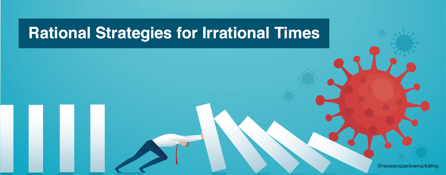Best Lead Gen Tactics for Industrial & Manufacturing Space

Let’s be honest here: B2B lead generation is not easy for manufacturers. With long sales cycles and complex products, it can be tricky to come up with a strategy that fits your goals.
So what can you do? We’ve compiled the top B2B lead generation tactics to help you work smarter—not harder. Try integrating these tactics in your strategy and watch your leads explode!
The Three Stages of Leads
Not all leads are created equal—it’s crucial to be able to differentiate stages of leads and how they relate to the buyer’s journey.
Here’s a rundown of the three different types of B2B leads:
New Leads
At this stage, the lead provides their information in exchange for useful content. The lead gets directed to a thank you page, where they’ll be able to download gated content (ebooks, case studies, webinars, etc.). Further nurturing is necessary for the lead to move on to the next stage.
Marketing Qualified Lead (MQL)
When a lead shows interest in a brand’s product to solve their issues, they become an MQL. At this point in the buyer’s journey, it is possible to lead them to the decision stage.
Sales Qualified Lead (SQL)
Once an MQL is ready to proceed to the decision stage, they become a sales qualified lead (SQL). It’s now up to your sales team to follow up fast to make a sale.
Strategy Before Tactics
We know you want to jump right into using all those digital marketing tricks and tips you’ve heard so much about, but diving in headfirst is not in your best interest.
Before you start using all those new B2B lead generation tactics, you must figure out how they fit into your overall content marketing strategy. So what do you need to do first?
Create a Buyer Persona
Every effective B2B lead generation strategy should start with your persona. Who is it that you’re trying to reach? Take the time to understand critical factors about your persona, including:
- Demographics: Your ideal customer’s age, gender, education level, and income level.
- Goals: What are your audience’s goals, and how can you help them get what they want?
- Challenges: What challenges or issues does your audience experience, and how can you solve them?
- Where do they get their information: Which social channel or blog do they frequently use?
- What can you do: What product or service do you offer that will resolve their issues?
- Common objections: What objections go through your typical customer’s mind as they consider your offer?
Get your sales team to help you when creating your target persona. Ask them why deals do and don’t pan out, what concerns potential customers have, and what questions frequently come up during meetings.
Think about interviewing existing clients who represent your ideal lead.
Set Your Business Goals
No strategy is complete without clearly defined goals. Otherwise, how can you know if you’re making progress?
All goals should be set with the S.M.A.R.T framework. B2B lead generation goals should be:
- Specific: Be precise about your goals. How much do you want to boost your lead generation?
- Measurable: Identify metrics you can use to ensure you’re going in the right direction.
- Attainable: Goals must inspire action, not discourage your team. Be realistic about what you can achieve.
- Relevant: Make sure that your objectives align with your company’s current needs and budget.
- Time-bound: Set a deadline for the goal. When should your team report on their progress?
Smarter B2B Lead Gen Tactics For Industrial & Manufacturing Marketing
Once you know who you’re targeting and you’ve defined your goals, it’s time to get into tactics that’ll generate leads.
Remember that the tactics you use will be based on your needs. Not every manufacturing company will use the same content marketing tactics; think about what will work for you and include it in your documented strategy. Here are some examples of great B2B content marketing examples and tactics that we often suggest.
Video Marketing
If you’re not using video in your digital strategy, then you are missing out. 54% of online consumers expect to see more video content from brands on social media.
Inbound marketing is all about adapting, and video marketing is here to stay. Often, B2B companies see the most success with these types of video marketing:
Live streaming
Many social platforms offer the possibility to host live streams on your profile. Nothing connects you better with your audience than real-time interaction. Hosting live streams is also cost-effective and doesn’t require much preparation.
Webinars
While live streams are available to any user logged in, webinars need pre-registration to join. Webinars offer an opportunity to showcase your authority and knowledge to your audience.
They’re also great for product promotion, and if you make them interactive, they could potentially produce many new qualified leads.
Want to host a webinar or stream a live video? It matters what kind of content that video includes. The most effective forms of video content for lead generation include:
Q&As
Looking to engage with your audience authentically? Host a Q&A! During Q&As, users comment their questions about your business while your team replies in real-time. Inviting your audience to join the conversation shows that you value their opinion.
Behind the scenes footage
Your audience wants to know what goes on behind the creation of your product or service. Use this as an opportunity to show what goes on behind the scenes at your company! Show a quick tour of your headquarters, a sneak peek of a new product, or your company culture.
Here’s an example showcasing one of our AgriTech clients, Living Green Farms, using video to showcase behind the scenes footage of their process and workflow.
You might even attract new talent drawn to your employees and how you do business.
Interview with an industry leader
We all love getting insights into how to improve our business or life from the best of the best. Connect with influencers in your niche and host an interview via live stream or webinar. Similar to Q&As, you can use user comments as questions for your interviewee.
Good example: Check out our video interview with Micatu‘s CEO Michael Oshetski, that we created for our Webcast/Podcast series, the Green New Perspective.
Instructional videos
Offer tutorials to your audience that’ll help them solve their issues or challenges. You can also promote your products and services in the end for those who want to take their skills further.
Create and Run Contests On Social Media
If you’re looking to generate leads left and right, you can’t go wrong with a social media contest.
The concept of contests is simple: you reward your audience with a valuable prize in exchange for their engagement.
Here are some ideas of contests/giveaways you can host on social media:
Quizzes/trivia questions
Test your audience’s knowledge. Ask a question in your post and invite your audience to comment on their answers. Randomly pick a winner with the correct answer and reward the user with a gift.
Event-based contests
National events represent an excellent opportunity to host contests on social media. The relevancy of the contest will get users to join in droves.
Photo contest
For example, ask your audience to publish a post using your product with a unique hashtag. Photo contests are also a great way to generate UGC (user-generated content).
Sweepstakes
Get your users to sign up on a landing page for the chance to win a prize. Promote the link on social media to your audience. You might get fewer contestants, but you’ll generate quality leads that you can target later.
Add Pop-Ups To Your Blog
Ever wondered why every site you come across has pop-ups? Because they work.
Pop-ups catch the visitor’s attention and get them to take action (download an eBook, try out a product demo, etc.). They work wonders when it comes to lead generation.
The three main types of pop-ups to include on your company blog include:
Blog scroll pop-ups
As the visitor scrolls down on one of your blog posts, this pop-up appears calling for some form of action. Usually, the pop-up invites users to sign up for a newsletter or to download some gated content. An example could be "Enjoying what you’re reading? Get your free copy of our 2025 electric industry report!"
Timed pop-ups
People’s attention spans are getting shorter—the average user will only read 28% of the words on a webpage. The solution? Timed pop-ups. These pop-ups only appear once the visitor has spent a specific amount of time on your page.
Exit pop-ups
It’s quite common that visitors will land on your website, only to quickly leave. With exit pop-ups, you get one last chance to convert the visitor into a lead. As soon as the visitor is about to leave, an exit pop-up will appear offering a free trial or promo code.
Understanding your visitors’ behavior helps determine how to use pop-up ads appropriately. We recommend using Google Analytics to help analyze your website traffic; it comes with relevant information such as bounce rate and average session duration.
Network With B2B Influencers
Thanks to social media, networking with influencers in the manufacturing space has never been easier.
Collaborating with influencers widens your audience reach and creates awareness. They can promote your company and get their audience to buy your product or visit your site. As a result, you’ll get more opportunities for lead generation!
So how do you do it? Here are our universal tips for reaching out on social media:
Find the right B2B influencers
Look for trending hashtags in your industry on social media and scan each account you see. Find accounts with high engagement and note them down.
Follow their online presence
Before you reach out to them, they first need an idea of who you are. You can make yourself known by subscribing to their blog, following them on social media, and commenting on their posts.
Direct message them
After you have engaged with their content, now’s the time to reach out to them via DM. Make sure to highlight how collaborating with your company will benefit them.
Rinse and repeat
Remember that this is a number’s game—message B2B influencers until you get one that wants to collaborate with you.
Optimize Your Site for Conversions
Driving traffic to your website is only half the battle. Getting visitors means nothing if no one converts.
Conversion optimization involves boosting the percentage of visitors that turn into clients.
Here are our top tips for optimizing your website for conversions.
Add Client Testimonials
Who knows how useful your product is better than your clients? Testimonials assure leads that they are making the right choice by working with your company. A good practice is to use them on your homepage and landing pages.
Implement UGC (user-generated content)
Like testimonials, UGC from customers is an excellent form of social proof. Add pictures of clients using your product throughout your company website.
Value proposition
Your offer needs to be clear in the eyes of your visitors. How will your product benefit the prospect?
Add a chatbot
A live chat feature on your site helps address the prospect’s concerns. If no one on your team is present, the bot gathers the visitor’s information and creates a ticket.
Use a conversational tone
Complicated language on your website will only repel visitors. Don’t forget that the people behind the screen are human too—keep your tone simple, as you would when talking to a friend.
Nurture Leads with Email Marketing
Email marketing hand-delivers messages to leads throughout their decision-making process.
However, that does not mean you should send batch-and-blast emails to all your contacts. The wrong email strategy will only lose your leads’ trust and get them to unsubscribe—or worse, mark you as spam.
Here’s how to nurture your leads with email:
Qualify your leads
Earlier in the article, we discussed the three different types of leads. Make sure you figure out which stage the lead is in the sales funnel.
Use segmentation
Segment your leads by criteria such as actions taken, demographics, or company position. Doing this ensures you’re sending the right email to the right person at the right time.
Tailor your emails
Send emails that align with the lead’s journey. For example, if the lead is ready to make a buying decision, send them an email to offer a consultation call.
Automate your email campaigns
Automation makes it easy to examine how leads are responding to your emails. You’ll know which leads opened your emails and which converted into customers.
Boost Your Online Efforts with Offline Efforts
Finally, remember that the internet isn’t the only place to generate leads. You can generate leads in real life too! There is no shortage of live events in the manufacturing industry, so don’t be afraid to get yourself out there. Make sure to look out for:
- Trade shows
- Industry events
- Networking events
- Conferences
As you network with potential leads, make sure to follow up by sending emails or connecting with them on LinkedIn.
B2B Lead Generation Starts With Strategy
Lead generation doesn’t have to be difficult. But let’s be real: a lot of building products manufacturers or industrial manufacturers have tried many of these B2B lead generation tactics and had no success.
Why? They skip (or rush) that essential strategy phase. There’s a reason we included it at the top of this page: it’s vital. Building a strategy takes time and must be implemented with care—these tactics are great, but they’re not instant fixes.
Start with strategy. Figure out who you’re marketing to and what your goals are, and it will be easier to decide which tactics will help you get there.




